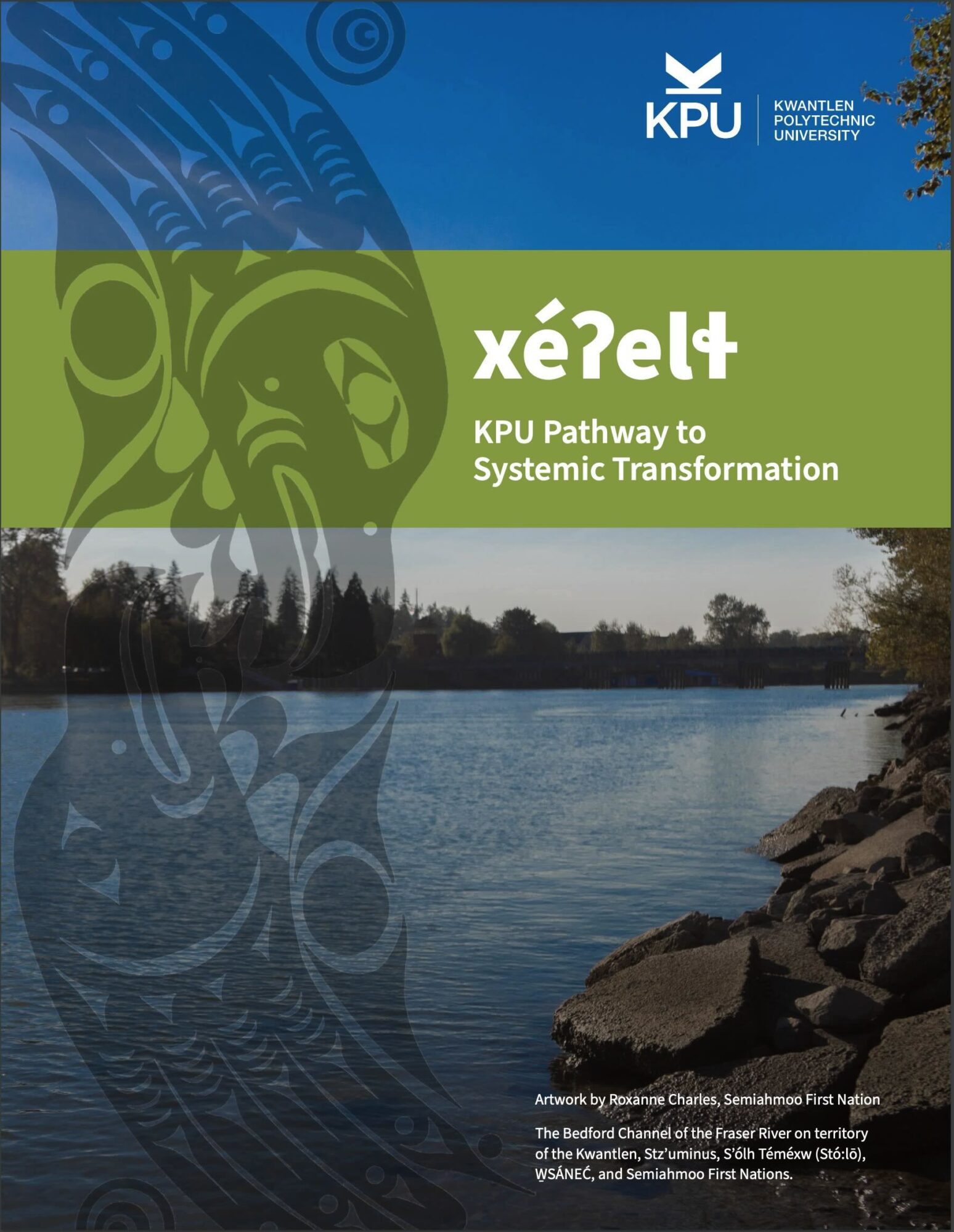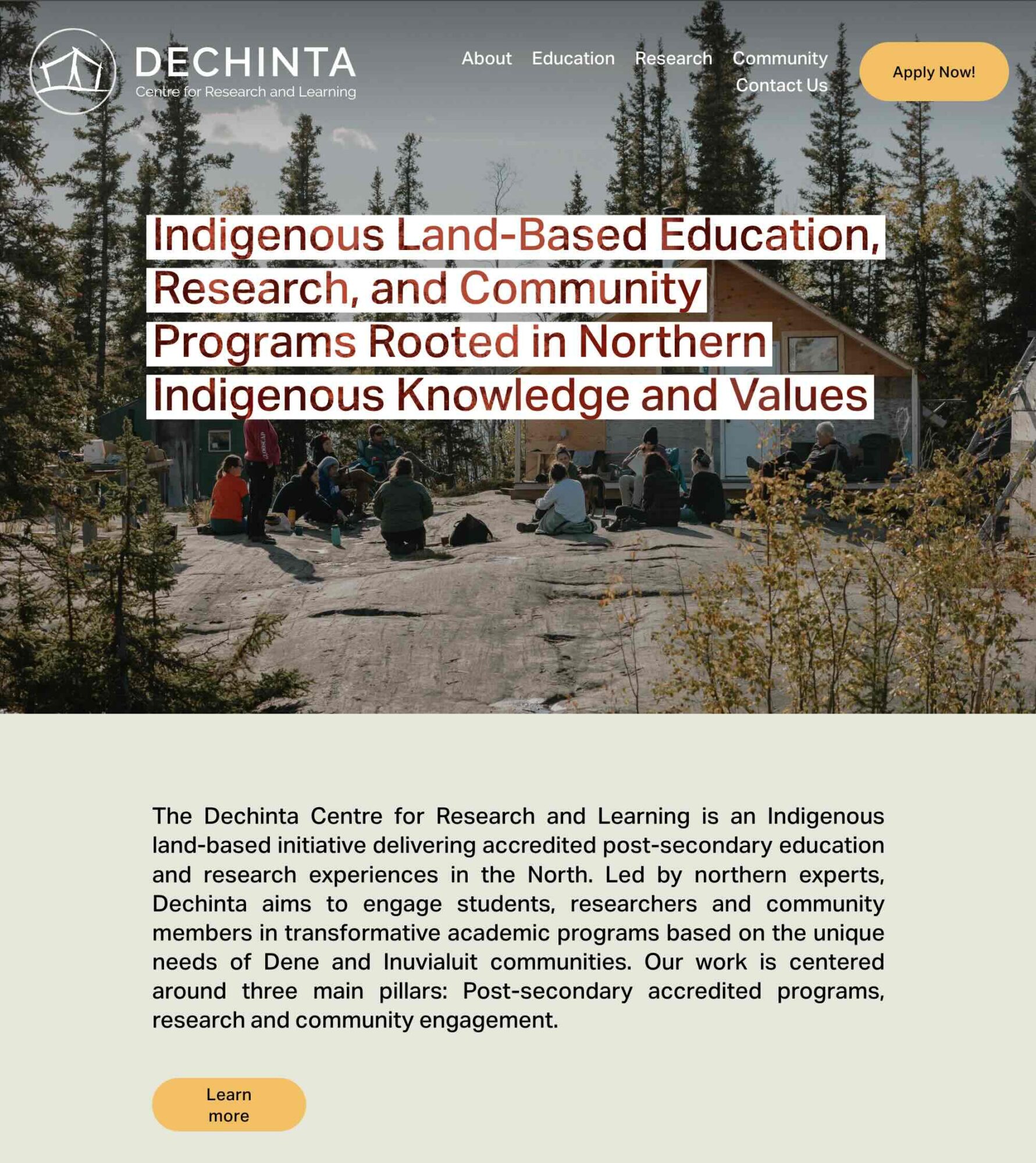River
Stretch your learning and reflect on your biases
I want to stand by the river in my finest dress. I want to sing, strong and hard, and stomp my feet with a hundred others so that the waters hum with our happiness. I want to dance for the renewal of the world.
robin wall kimmerer
SECTION 2 – RIVER
This section of Decolonizing Educational Practices includes information on seven First Nations local to KPU, authentic Indigenous resources, the xéʔelɬ Pathway to Systemic Transformation, cultural safety, accountable spaces, being a good ally, Etuaptmumk (two-eyed seeing), learning on the land, and authentic assessment.
Learn About the Territories You are On
More details are provided below on the seven First Nations on which the five KPU campuses are collectively located. Please note that these are only starting points. Each First Nation holds myriad stories and diversities of knowledge. You might also explore A Stó:lõ-Coast Salish Historical Atlas available at KPU libraries.
qw̓ ɑ:nƛ̓ ə̓ n̓ (Kwantlen)
Kwantlen means “Tireless Runner” in Halkomelem. Part of the Stó:lō people, they now operate as an independent Nation and traditionally speak hən̓q̓əmin̓əm̓, a Halkomelem dialect. Kwantlen Traditional Territory includes Richmond, New Westminster, Surrey, Langley, east to Mission, and to the northern end of Stave Lake. Seven traditional laws guide their ancestors since time immemorial: health, happiness, generations, generosity, humbleness, forgiveness and understanding.
xʷməθkʷəy̓əm (Musqueam)
Musqueam means the place of the məθkʷəy̓ (river grass). They are a matriarchal, self-governing nation, and have stewarded the mouth of the stɑl̓əw̓ (Fraser River) since time immemorial. Their oral histories, language, and ceremonies have strong ties with their lands and waters. Musqueam’s flag features a salmon jumping above a net, and was designed by Susan Point and permanently raised at UBC’s Point Grey in 2019.
Read: Unveiling the River’s Secrets: A Musqueam Woman’s Journey of Environmental Stewardship
qi̓ cə̓ y̓ (Katzie)
Katzie means “Land of the Moss.” They speak the traditional hənq̓əmínəm̓ language. Rivers, sloughs, and other wetlands are central to their culture, and sq̓ə́yc̓əyaʔɬ x̌acaʔ (colonial name is Pitt Lake) is located at the centre of their territory. They continue to steward these lands and waters through protection and restoration guided by traditional practices.
Read: Katzie First Nation Calls for Urgent Action on sánəsaʔł (Alouette) River Restoration
Read/Watch: Katzie Elder Enjoys Teaching her Nation’s Culture and History
SEMYOME (Semiahmoo)
The Semiahma nation has a long and deep connection with the ocean and fishing. The Oregon Treaty in 1846 divided their territory, coercing the Semiahma members to decide to remain a member of Semiahmoo in Canada, or to join the Lummi and Nootsack in the United States. Their worldview includes respect for Elders and the environment, and to stop violence against their waters and lands.
Read: Xw’epiteng Elementary: South Surrey School Receives New Name from Semiahmoo
scə̓ waθən (Tsawwassen)
Tsawwassen means “Land Facing the Sea.” Their territory stretches from Pitt Lake to across the Salish Sea and the Gulf Islands. Fish are central to their culture and identity, and the Tsawwassen People harvest salmon, eulachon, and crab as they have done for thousands of years. In 2009 they confirmed the first urban First Nations Treaty in BC, restoring their right to self-government.
Read: Tsawwassen First Nation Sustainable Agriculture Project
qiqéyt (Qayqayt)
Qayqayt is the name of a 19th century village that existed along the shores of the stɑl̓əw̓ (Fraser River) in New Westminster, and means “Resting Place.” Colonization, smallpox, and the McKenna McBride Commission conspired to erase Qayqayt; their story was reignited by Rhonda Larabee, whose mother was one of the last living Qayqayt members. Qayqayt is the only First Nations in Canada to be registered without a land base. Larabee is active in advocating for First Nations education.
Read: Chief Rhonda Larrabee of the Qayqayt First Nation named as Douglas College’s 2021 Honorary Fellow
kwikwəƛə̓ m (Kwikwetlem)
kwikwəƛə̓ m means “Red Fish up the River,” referring to the sockeye salmon that once spawned here prior to the Coquitlam Dam construction. The kwikwəƛə̓ m are descended from master salmon and sturgeon fishers, canoe builders, and winter dancers. Their traditional territories are connected to the watershed of skʷƛ̓əma:ɬ x̌acaʔ (Coquitlam Lake), as well as skʷƛ̓əma:ɬ stál̕əw̓ (Coquitlam River) and Pitt Lake.
Read: Addressing dike issues to help Kwikwetlem First Nation move past historical grievances
Our stories are meant to be dynamic in nature, every storyteller making changes to meet the needs of the listener and as an acknowledgement of the ever-changing tides of our world.
jennifer grenz
Authentic Indigenous Resources
An important way to change the colonial narrative and amplify voices long silenced is to incorporate into your educational practice works and art by Indigenous Peoples. Jo Chrona, in her book Wayi Wah!, outlines criteria to consider before adopting a resource, some of which include:
- Resource created by or in deep collaboration with First Nations, Métis, or Inuit
- Recognizes diversity between and among Indigenous Peoples
- Shows Indigenous Peoples’ as enduring with contributions to contemporary society
- Portrays Indigenous Peoples’ languages and dialects respectfully
- Avoids stereotypes and uses sensitive language
The χʷəχʷéy̓əm Indigenous Collection, located in KPU libraries, is a great place to start.
This Find Indigenous Voices” KPU LibGuide can help students (and instructors) find Indigenous authors.
The Indigenous Information Literacy Pressbook provides a detailed outline for working with Indigenous sources in university.

xéʔelɬ Pathway to Systemic Transformation
Developed in consultation with KPU’s Indigenous Advisory Committee, xéʔelɬ provides six pathways to move us toward systemic transformation. These pathways recognize KPU’s commitment to uphold the Truth and Reconciliation Commission of Canada’s Calls to Action, the United Nations Declaration on the Rights of Indigenous Peoples, and the Calls for Justice connected to the National Inquiry into Missing and Murder Indigenous Woman, Girls and 2SLGBTQQIA people.
The six pathways are:
- Reflecting upon our own biases
- Open to the Community
- Indigenous Voices Matter
- Holistic Learning and Well-being
- Weaving Indigenous Worldviews
- Thought Meets Action
Read the full guide (PDF version). Hard copies are also available in The Gathering Place at KPU Surrey.
Reflecting Upon Our Own Biases
The decolonization journey includes engaging in personal growth by examining our biases and beliefs regarding Indigenous Peoples. Reflecting upon our own biases is the first Pathway of xéʔelɬ Pathway to Systemic Transformation, emphasizing its importance as a fundamental aspect of decolonial work. Ask yourself questions such as, What has informed my perception of Indigenous Peoples? Whose voices were silenced? Have I learned from authentic Indigenous voices? What is my positionality and how does that influence my understanding and misconceptions of Indigenous Peoples? Writing a positionality statement is a powerful way to explore how we are situated, and perceive and act, within our society.
Western beliefs have been reinforced by colonialism and an education system that has largely misrepresented or ignored Indigenous voices for over 150 years in Canada. In addition to the recommendations made in xéʔelɬ, here are three ways to examine your preconceptions and underlying assumptions.
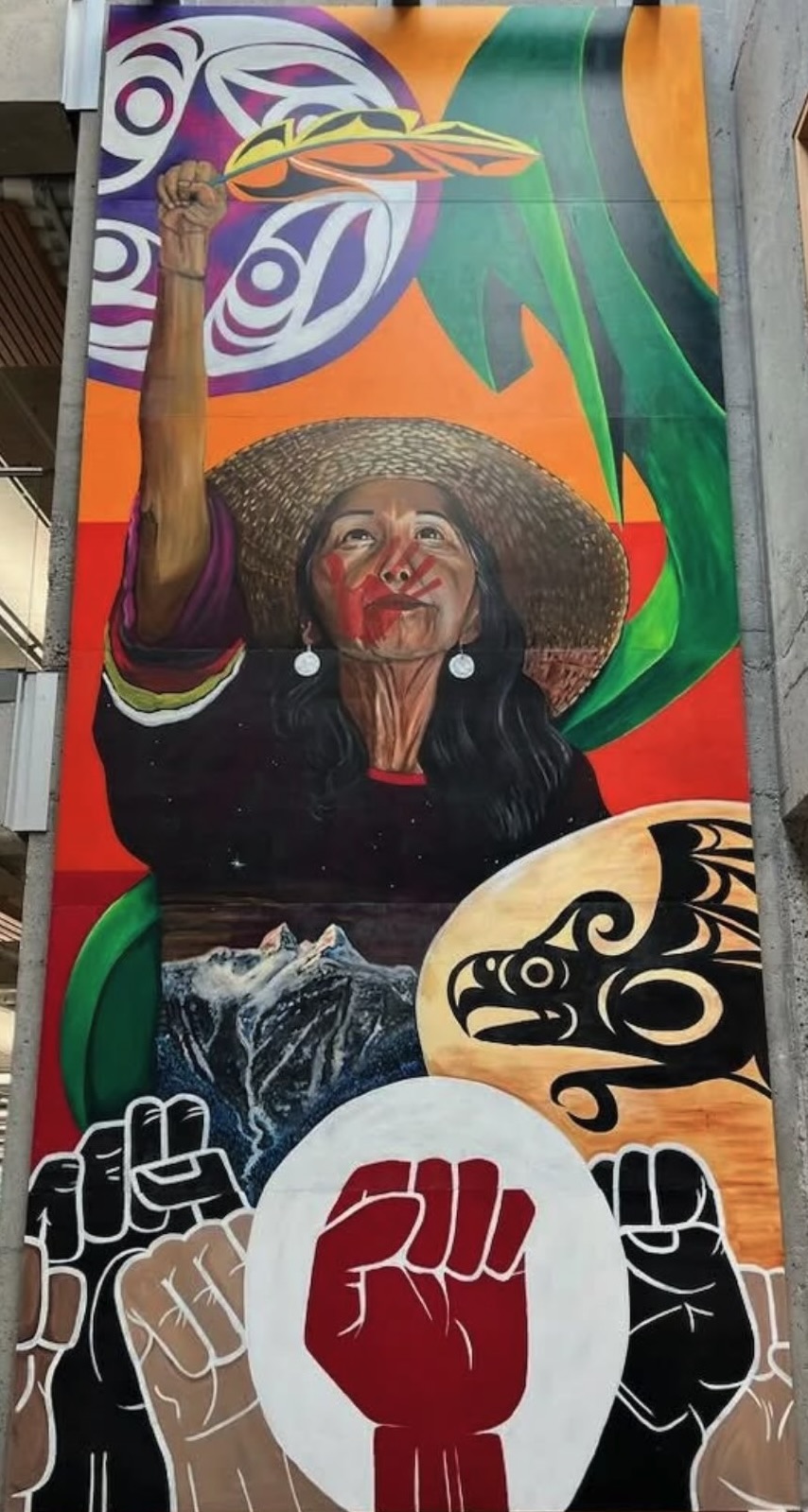
Cultural Safety for Indigenous Students and Employees
Cultural safety is crucial at a post-secondary university because it ensures an environment where Indigenous students and employees feel respected, valued, and understood. This approach acknowledges their unique histories, experiences, and perspectives, addressing systemic barriers and fostering a sense of belonging. By promoting cultural safety, universities can create inclusive spaces that support the academic and professional success of Indigenous individuals, ultimately contributing to a more equitable and diverse academic community.
Accountable Spaces
You may have heard of safe or brave learning spaces. The idea is to create an environment where participants will not be harassed or harmed and can be their authentic selves with the confidence to lean into fear, be vulnerable and mindfully share experiences. Although well-intentioned, these ideas are problematic since we cannot predict people’s actions or expect those who are most vulnerable to advocate for themselves.
As outlined by Elise Ahenkorah:
- “safe spaces don’t exist for equity-deserving communities—or for those learning about identity and privilege” as we need to be challenged and sometimes feel uncomfortable in order to see with fresh eyes.
- Brave spaces “negate the daily bravery marginalized communities need to display everywhere, to navigate everyday and common biases, discrimination, and microaggressions, in workplaces and society.” They can be exhausting and add burden to those facing daily oppression.
Accountable spaces create shared responsibility for equity and inclusivity. As Ahenkorah writes, “Accountability means being responsible for yourself, your intentions, words, and actions. It means entering a space with good intentions, but understanding that aligning your intent with action is the true test of commitment.”
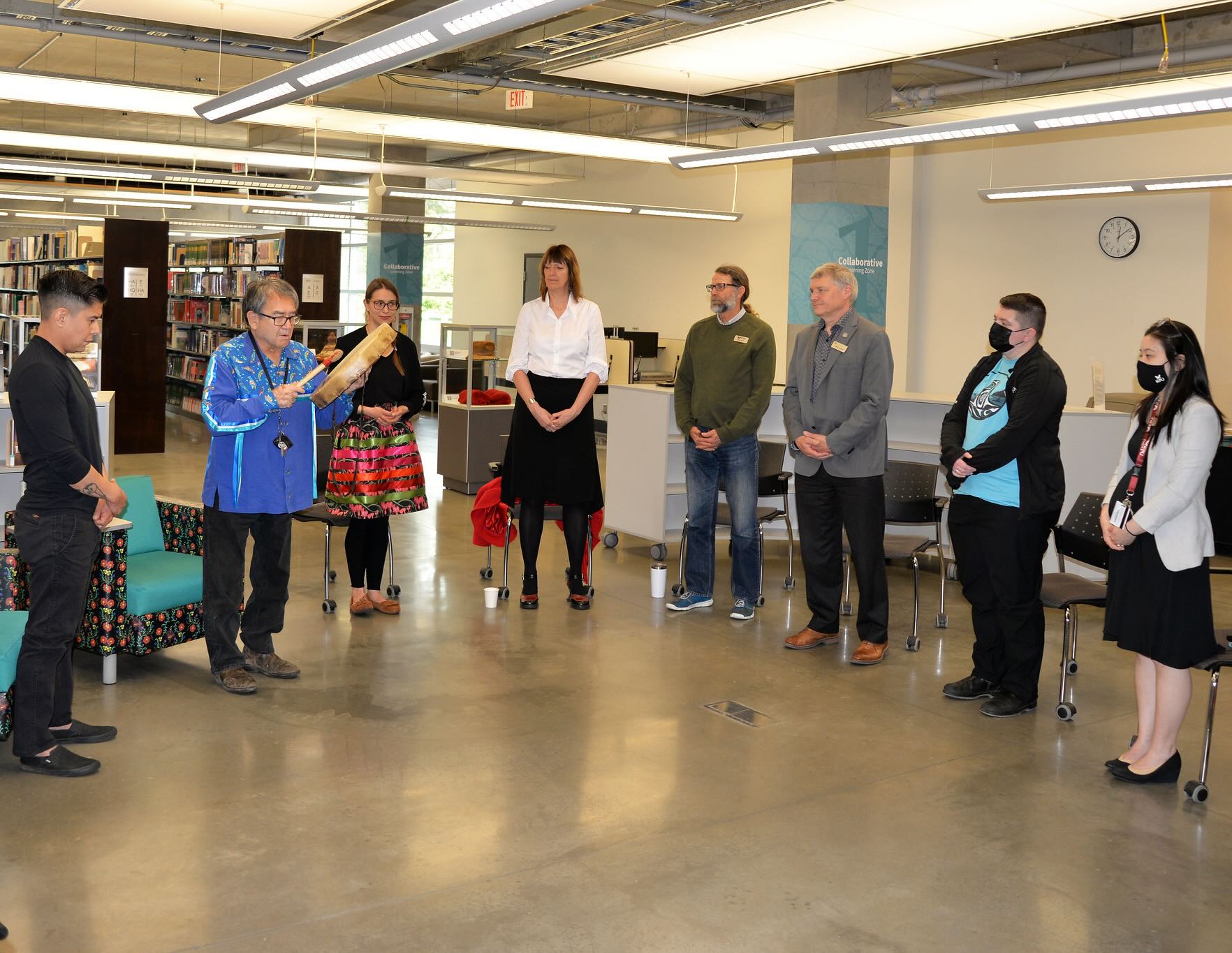
Some of the ways you can cultivate an accountable space:
- Speak on your behalf, and not for others. Use “I” statements.
- Engage in active listening without interrupting others. Focus on who is speaking now; try not to focus on what you are going to say when it comes your time to speak.
- Give everyone an opportunity to speak, but without pressure to do so.
- Provide space for marginalized community members to share.
- Apologize for words spoken that are offensive or problematic.
- Acknowledge the source of your ideas, including when re-stating something previously spoken by someone else.
- Be mindful of body language and tone.
- You may have a negative impact without intentionally doing so. Take ownership of this impact.
Links:
Safe and Brave Spaces Don’t Work (and What You Can Do Instead)
York’s Accountable Space Resources
Being a Good Ally or Advocate
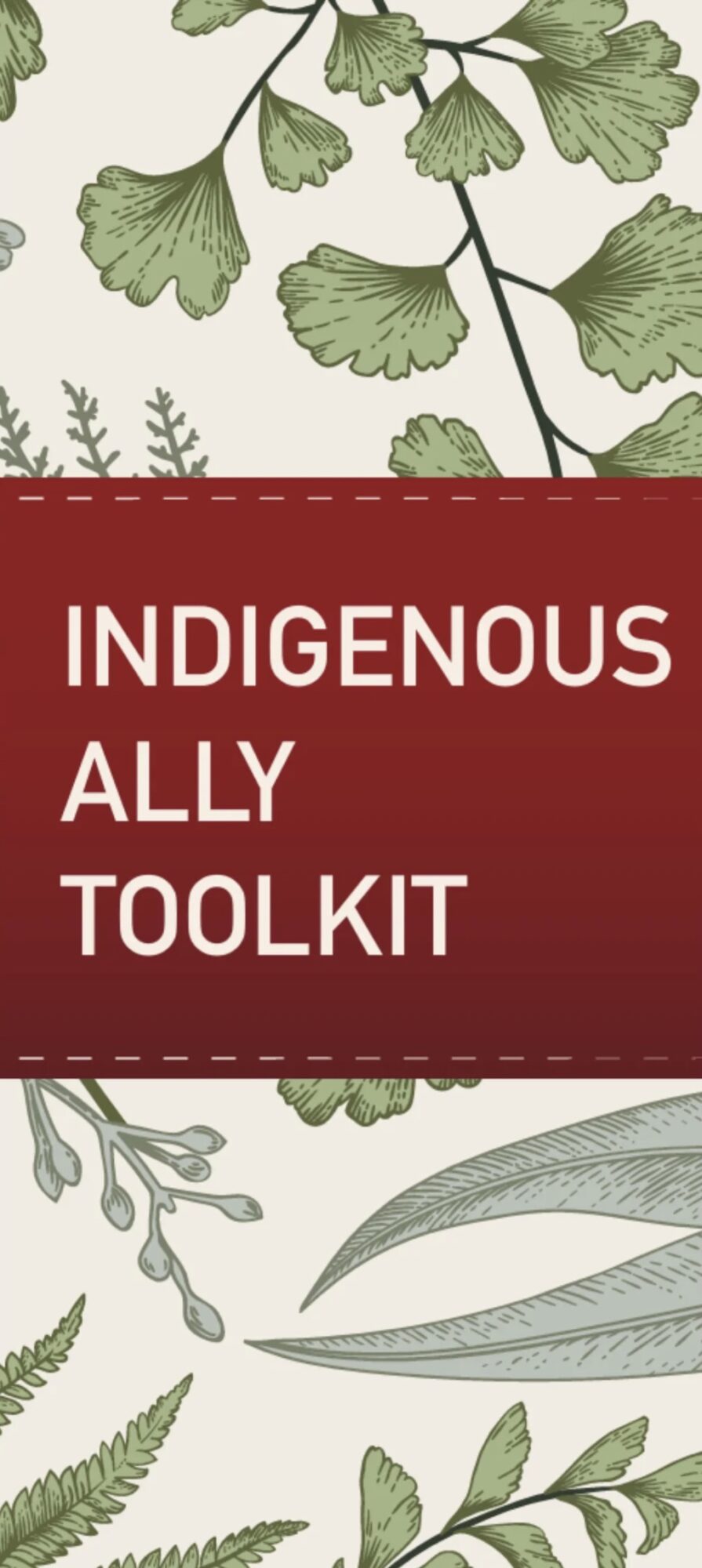
First, a note on the usage of the term Ally. Len Pierre shared that being described as an ‘ally’ is earned. An Indigenous educator might describe their settler-colleague as an ally for the work they do, but non-Indigenous colleagues should refrain from describing themselves this way. ‘Ally’ is a term that is given, not claimed.
Here are some ways to be a good ally, inspired by the Indigenous Ally Toolkit:
- Speak up even when it feels scary
- Transfer your privilege to those who have less
- Acknowledge that you are an uninvited guest on this land
- Respect local cultural protocols and traditions
- Amplify Indigenous voices
The Indigenous Ally Toolkit reminds us that being an ally and working towards decolonization is an ongoing process: At the end of the day, being an ally goes beyond checking actions off a list and it is not a competition. Being an ally is about a way of being and doing. This means self-reflection, “checking in” with one’s motivations and debriefing with community members is a continual process; it is a way of life.
Advocacy
Being a good advocate (or accomplice) means working within the system and confronting colonization and other institutionalized racism. While an ally may offer active support to marginalized groups, advocates take direct action toward anti-racism and removing systemic barriers. Advocates are willing to step into discomfort and risk their position—a privileged one—in order to challenge and disrupt institutionalized oppression.
Additional Links:
Indigenous Ally Toolkit (Montreal Indigenous Community Network)
Indigenous Ally Toolkit (Calgary Foundation)
Carolyn Roberts blog post: “Moving from performative to accomplice”
Etuaptmumk (Two-Eyed Seeing)
This TEDx Talk by Mi’kmaw spoken word artist Rebecca Thomas encourages us to focus on the strengths of two different worldviews: Indigenous and Western. We can learn to weave between Indigenous ways of understanding and Western ways of understanding, depending on the circumstance, and consider how they can complement our thoughts and actions to benefit the world. Two-eyed seeing attempts to avoid cultural clashes, or the assimilation of one culture by another. Mi’kmaw Elder Albert Marshall explains: “Two-Eyed Seeing is hard to convey to academics as it does not fit into any particular subject area or discipline. Rather, it is about life: what you do, what kind of responsibilities you have, how you should live while on Earth.”
Learn on the Land
Robin Wall Kimmerer calls land-based pedagogy “authentic whole-person learning.” The simple act of walking your class outside can decolonize learning and shift excitement and engagement, and is a great opportunity for relationship and community building and to connect with the natural world. For any course, take your learning out of the classroom, and gather on the campus grounds or at a local park or greenway. You can also arrange (with permission) a visit to a local First Nations community.

In her book Re-storying Education, Carolyn Roberts offers some questions to ask ourselves about the land we are on:
- Who has been displaced in order for us to be here today? This includes humans and the more-than-humans.
- How has colonization impacted the land you live upon? And the peoples whose land it is?
- How does this impact the work you do as an educator?
As Kimmerer writes about leading field experiences:
“They come away knowing more plants, more processes, more chemistry, and more ecology than when they began and knowing it in a different way, through direct relationship of mind, body, emotion, and spirit—not because I have taught them, but because the land has. They walk humbly on the trails not as through a warehouse from which they take, but as through a home, from which they receive. This is the beginning of reciprocity. I do not think it is possible to engage in reciprocity without first experiencing the gifts of the land and then being drawn to return a gift in kind.”
KPU Wild Spaces can help connect you with local outdoor spaces at and near the KPU campuses.
Dechinta Centre for Research and Learning
Dechinta offers Indigenous, land-based post-secondary teaching and research experiences
From their website: “At Dechinta, our approach to teaching and learning is rooted in decolonizing and land-based pedagogy. Many Western institutions and schools have outdoor education programs that do not view education or the land in the same way as an Indigenous land-based pedagogy does. Indigenous land-based learning emerges from Indigenous frameworks of intelligence which view the land as a mode of education and a source of knowledge. Dechinta programs are not just education delivered outdoors, it is about having our students learn from and with the land in ways that transform how they understand themselves and the world around them.”
Authentic Assessment
When students finish a course and all they remember (or care about) is their final grade, something is amiss. Authentic assessments are relevant and meaningful for students. They de-emphasize testing, rote memorization, hierarchy, and linear learning and promote a culture of relational learning, formative feedback, and multiple assessment methods that build confidence and community. Cultivate an environment where learners feel confident to make, and learn from, mistakes.
Some guidelines for authentic assessments:
Holistic
Focus on all aspects of the learner, including social, emotional, physical, spiritual, and intellectual. Experiential learning, movement, and reflective activities can help de-center the cognitive element and promote holistic education.
Flexible Deadlines
Allow students to submit assignments late when needed, and allow for resubmissions so they can incorporate your feedback on the first version.
Provide Examples
If students engage in projects or presentations, provide practice tasks and previous examples of student projects/presentations. If your students take exams, provide sample questions or previous exams.
Avoid Time-limited Tests
These heighten stress and may unfairly judge students on their ability to process information quickly. Assess in ways that do not only focus on memory recall and writing.
Relevant & Engaging
Connect assignments and assessments to real-life situations that matter to your learners. Give them choice in their topics.
Multiple Assessments
Give students many options to demonstrate their learning, such as oral, written, presentations, visual, ePortfolios, and/or creative.
Co-create
Construct a grading rubric with your students, and/or provide a clear and concise rubric showing assessment expectations.
Encourage Storytelling
Have students demonstrate their learning through sharing stories, including digital (audio, video, etc.).
Additional Links:
Indigenous Pedagogy Assessment
Culturally Responsive Assessments
“What Does the Earth Ask of Us?”
In this webinar for KPU, Robin Wall Kimmerer speaks to her book Braiding Sweetgrass and how we can live in better relation with the world and each other. She addresses how sustainability can no longer be taken for granted, and that we need to ask, “What can we give?” She explains how Indigenous philosophy and Western science can work in parallel. Kimmerer shares her journey as a young botanist, and how she felt she didn’t belong as a university student when her professor said “That’s not science” in reference to her traditional knowledge. The pyramid of human exceptionalism, land as identity, linguistic imperialism, defending knowledge diversity, the grammar of animacy, and the rights of nature movement are also discussed.

